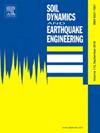Seismic fragility analysis for underground subway station structures considering ground motion combinations based on IDA and cloud
IF 4.2
2区 工程技术
Q1 ENGINEERING, GEOLOGICAL
引用次数: 0
Abstract
Cloud and incremental dynamic analysis (IDA) are the two most commonly used methods for seismic fragility analysis. The two methods differ significantly in the number of ground motions and whether these motions are scaled. This paper designed a random selection procedure to thoroughly discuss the influence of ground motion combinations encompassing different numbers of motions on the Cloud-based and IDA-based seismic fragility analysis for underground subway station structures. Focusing on a shallow-buried single-story station structure, a nonlinear dynamic time-history finite element analysis model of soil-structure interaction was developed. 400 ground motions were selected for random combination to perform Cloud-based seismic fragility analysis, and 20 ground motions were selected for random combination to perform IDA-based analysis. The results showed that the number of ground motions has a significant influence on the seismic fragility analysis in both Cloud and IDA, especially on the prediction of damage probability for higher seismic performance levels and when the PGA exceeded 0.3 g. In regions with a low probability of strong earthquakes, this paper recommended using no fewer than 10 and 220 ground motions in the IDA-based and Cloud-based seismic fragility analyses, respectively. In regions with a high probability of strong earthquakes, the optimal number of ground motions should be increased to 300 for Cloud-based analysis and 15 for IDA-based analysis.
考虑地震动组合的地下地铁车站结构地震易损性分析
云和增量动力分析(IDA)是地震易损性分析中最常用的两种方法。这两种方法在地面运动的数量和这些运动是否被缩放方面有很大的不同。本文设计了一种随机选择程序,深入讨论了包含不同运动次数的地震动组合对基于云和基于ida的地铁车站结构地震易损性分析的影响。针对某浅埋单层车站结构,建立了土体-结构相互作用的非线性动力时程有限元分析模型。选取400个地震动随机组合进行基于云的地震易碎性分析,选取20个地震动随机组合进行基于ida的地震易碎性分析。结果表明,地震动次数对Cloud和IDA的地震易损性分析有显著影响,特别是对较高抗震性能等级和PGA超过0.3 g时的破坏概率预测。在强震概率较低的地区,本文建议在基于ida的地震易损性分析和基于云的地震易损性分析中分别使用不少于10次和220次地面运动。在强震发生概率较高的地区,基于云的分析应将最佳地震动次数增加到300次,基于ida的分析应增加到15次。
本文章由计算机程序翻译,如有差异,请以英文原文为准。
求助全文
约1分钟内获得全文
求助全文
来源期刊

Soil Dynamics and Earthquake Engineering
工程技术-地球科学综合
CiteScore
7.50
自引率
15.00%
发文量
446
审稿时长
8 months
期刊介绍:
The journal aims to encourage and enhance the role of mechanics and other disciplines as they relate to earthquake engineering by providing opportunities for the publication of the work of applied mathematicians, engineers and other applied scientists involved in solving problems closely related to the field of earthquake engineering and geotechnical earthquake engineering.
Emphasis is placed on new concepts and techniques, but case histories will also be published if they enhance the presentation and understanding of new technical concepts.
 求助内容:
求助内容: 应助结果提醒方式:
应助结果提醒方式:


